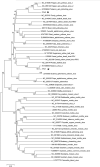Identification of two novel poleroviruses and the occurrence of Tobacco bushy top disease causal agents in natural plants
- PMID: 34702954
- PMCID: PMC8548504
- DOI: 10.1038/s41598-021-99320-x
Identification of two novel poleroviruses and the occurrence of Tobacco bushy top disease causal agents in natural plants
Abstract
Tobacco bushy top disease (TBTD) is a devastating tobacco disease in the southwestern region of China. TBTD in the Yunnan Province is often caused by co-infections of several plant viruses: tobacco bushy top virus (TBTV), tobacco vein distorting virus (TVDV), tobacco bushy top virus satellite RNA (TBTVsatRNA) and tobacco vein distorting virus-associated RNA (TVDVaRNA). Through this study, two new poleroviruses were identified in two TBTD symptomatic tobacco plants and these two novel viruses are tentatively named as tobacco polerovirus 1 (TPV1) and tobacco polerovirus 2 (TPV2), respectively. Analyses of 244 tobacco samples collected from tobacco fields in the Yunnan Province through RT-PCR showed that a total of 80 samples were infected with TPV1 and/or TPV2, and the infection rates of TPV1 and TPV2 were 8.61% and 29.51%, respectively. Thirty-three TPV1 and/or TPV2-infected tobacco samples were selected for further test for TBTV, TVDV, TBTVsatRNA and TVDVaRNA infections. The results showed that many TPV1 and/or TPV2-infected plants were also infected with two or more other assayed viruses. In this study, we also surveyed TBTV, TVDV, TBTVsatRNA and TVDVaRNA infections in a total of 1713 leaf samples collected from field plants belonging to 29 plant species in 13 plant families and from 11 provinces/autonomous regions in China. TVDV had the highest infection rates of 37.5%, while TVDVaRNA, TBTV and TBTVsatRNA were found to be at 23.0%, 12.4% and 8.1%, respectively. In addition, TVDV, TBTV, TBTVsatRNA and TVDVaRNA were firstly detected of co-infection on 10 plants such as broad bean, pea, oilseed rape, pumpkin, tomato, crofton weed etc., and 1 to 4 of the TBTD causal agents were present in the samples collected from Guizhou, Hainan, Henan, Liaoning, Inner mongolia and Tibet autonomous regions. The results indicated that TBTD causal agents are expanding its host range and posing a risk to other crop in the field.
© 2021. The Author(s).
Conflict of interest statement
The authors declare no competing interests.
Figures




Similar articles
-
Synergism Among the Four Tobacco Bushy Top Disease Casual Agents in Symptom Induction and Aphid Transmission.Front Microbiol. 2022 Apr 4;13:846857. doi: 10.3389/fmicb.2022.846857. eCollection 2022. Front Microbiol. 2022. PMID: 35444628 Free PMC article.
-
Simultaneous detection of four causal agents of tobacco bushy top disease by a multiplex one-step RT-PCR.J Virol Methods. 2014 Sep 1;205:99-103. doi: 10.1016/j.jviromet.2014.05.003. Epub 2014 May 14. J Virol Methods. 2014. PMID: 24833121
-
Signs and symptoms to determine if a patient presenting in primary care or hospital outpatient settings has COVID-19.Cochrane Database Syst Rev. 2022 May 20;5(5):CD013665. doi: 10.1002/14651858.CD013665.pub3. Cochrane Database Syst Rev. 2022. PMID: 35593186 Free PMC article.
-
Genetic Differentiation and Migration Fluxes of Viruses from Melon Crops and Crop Edge Weeds.J Virol. 2022 Aug 24;96(16):e0042122. doi: 10.1128/jvi.00421-22. Epub 2022 Aug 4. J Virol. 2022. PMID: 35924924 Free PMC article.
-
Systemic pharmacological treatments for chronic plaque psoriasis: a network meta-analysis.Cochrane Database Syst Rev. 2021 Apr 19;4(4):CD011535. doi: 10.1002/14651858.CD011535.pub4. Cochrane Database Syst Rev. 2021. Update in: Cochrane Database Syst Rev. 2022 May 23;5:CD011535. doi: 10.1002/14651858.CD011535.pub5. PMID: 33871055 Free PMC article. Updated.
Cited by
-
Synergism Among the Four Tobacco Bushy Top Disease Casual Agents in Symptom Induction and Aphid Transmission.Front Microbiol. 2022 Apr 4;13:846857. doi: 10.3389/fmicb.2022.846857. eCollection 2022. Front Microbiol. 2022. PMID: 35444628 Free PMC article.
-
Complete genome sequence of triticum yellow stripe virus, a new polerovirus infecting wheat (triticum aestivum) in China.Arch Virol. 2023 Apr 21;168(5):146. doi: 10.1007/s00705-023-05758-x. Arch Virol. 2023. PMID: 37083847
-
Characterization of Cucurbit Aphid-Borne Yellows Virus (CABYV) from Passion Fruit in Brazil: Evidence of a Complex of Species within CABYV Isolates.Viruses. 2023 Feb 1;15(2):410. doi: 10.3390/v15020410. Viruses. 2023. PMID: 36851624 Free PMC article.
-
Virome Analysis of Aconitum carmichaelii Reveals Infection by Eleven Viruses, including Two Potentially New Species.Int J Mol Sci. 2023 Oct 25;24(21):15558. doi: 10.3390/ijms242115558. Int J Mol Sci. 2023. PMID: 37958540 Free PMC article.
-
Carrot populations in France and Spain host a complex virome rich in previously uncharacterized viruses.PLoS One. 2023 Aug 16;18(8):e0290108. doi: 10.1371/journal.pone.0290108. eCollection 2023. PLoS One. 2023. PMID: 37585477 Free PMC article.
References
-
- Gates LF. A virus causing axillary bud sprouting of tobacco in rhodesia and nyasaland. Ann. Appl. Biol. 1962;50(1):169–174. doi: 10.1111/j.1744-7348.1962.tb05998.x. - DOI
-
- Mo, X.H., Wu, J.Y., Chen, H.R. Study on low molecular weight RNA related to tobacco bushy top disease. In Annual Meeting of Chinese Society for Plant Pathology (1998).
-
- Mo XH, Chen ZB, Chen JP. Molecular identification and phylogenetic analysis of a viral RNA associated with the Chinese tobacco bushy top disease complex. Ann. Appl. Biol. 2011;158(2):188–193. doi: 10.1111/j.1744-7348.2010.00452.x. - DOI
Publication types
MeSH terms
Substances
LinkOut - more resources
Full Text Sources

